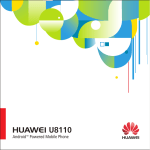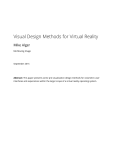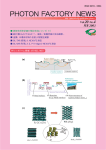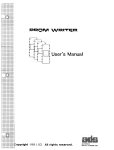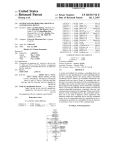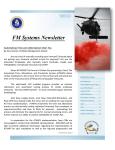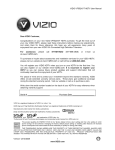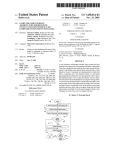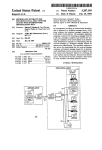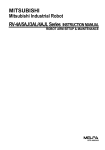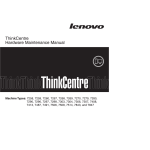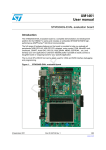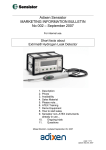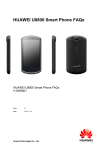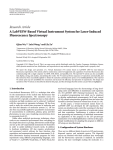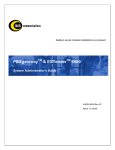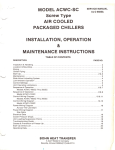Download License modes in call processing
Transcript
US007698225B2
(12) Ulllted States Patent
(10) Patent N0.:
Rhodes et a].
(54)
(45) Date of Patent:
LICENSE MODES IN CALL PROCESSING
5,204,897 A
5,206,903 A
5,230,020 A
Inventors: James EI Rhodes’ Boulder’
Robert J. SerkoWski, Broom?eld, CO
i
(US); William T. Walker, Evergreen,
’
CO (Us); Lawrence John Morgan’
_
Brqom?elds CO (Us), Mohana
Notice:
Apr. 13, 2010
4/1993 Wyman ....................... .. 380/4
4/1993 Kohler et al.
7/1993 Hardy 6t
................ .. 380/21
1
glYmanak t 1
’
lmaZ
i
5,347,580 A
,
,
1e 3'
glassmacher et al. ..... .. 379/189
ardy et a1. ................ .. 380/21
9/1994 Molva et a1.
Krlshnan Gopalakrlshna, Thornton,
5,386,369 A
1/1995 Christiano
CO (US)
5,390,297 A
2/1995 Barber et al.
5,408,649 A
4/1995 Beshears et a1.
(73) Assignee: Avaya Inc., Basking Ridge, NJ (US)
(*)
US 7,698,225 B2
Subject to any disclaimer, the term of this
patent is extended or adjusted under 35
5,448,639 A
9/1995 AraZi
5,553,143 A
9/1996 Ross et al.
5,563,946 A
10/1996 Cooper et a1.
(Continued)
U.S.C. 154(b) by 885 days.
FOREIGN PATENT DOCUMENTS
(21) App1.No.: 10/232,508
(65)
EP
Prior Publication Data
US 2004/0044629 A1
1071253 A1
1/2001
US. Appl. No. 09/357,679, ?led Jul. 20, 1999, Serkowski.
Mar. 4, 2004
(Continued)
(51) Int_ CL
Primary ExamineriEvens J Augustin
(52)
US. Cl. ...... .... ...... ... ......... .. 705/59; 380/231; 726/27
(57)
(58)
Field of Classi?cation Search ................... .. 705/1;
'
'
380/231; 370/372; 717/177
license manager 113 operable to identify the occurrence of a
.
178/2208
p redetermined licensing event and a mode setting a g ent 124
operable to change, in response to the occurrence of the
predetermined licensing event (e.g., an absence of a valid
license), from a ?rst licensing mode (e.g., a license normal
mode) to a second licensing mode (e.g., a license error mode).
_______ __ 380/21
Hazard ............. ..
________ __ 380/21
Marshall et al.
mode. In each of the ?rst and second licensing modes a
common set of features performed by the telecommunication
References Cited
US. PATENT DOCUMENTS
4,288,659
4,405,829
4,780,821
4,811,393
4,888,800
4,937,863
5,157,663
5,179,591
A
A
A
A
A
A
A
A
9/1981
9/1983
10/1988
3/1989
12/1989
6/1990
10/1992
1/1993
ROSS
The present invention is directed to a system, comprising: a
See 81313110811011 ?le for Complete Search hlstory(56)
0rABSTRACT
Atalla
Rivest et al.
Cro s sley
The second licensing mode is different from the ?rst licensing
application (e.g., call processing functions) are operational.
Robert et al.
Major et al.
Hardy et al.
...... .. ........ ..
380/21
42 Claims, 5 Drawing Sheets
[MINIMUM
ii15““ "I; """""""""""
: TELEEIIMMIJIIIEATIBII
1148
1|
H
|| AFFLICATIDII E‘I1.
1263
{E
I MDIJESITIIIIEAEENT I.
1245,
}: TIMEIVALLIE
5
(1 {""m'mmli
1;
‘ micnmmumcmnu
11mm")
1
“
H
:1 125311
{:1
"
147/
114"
Wm
: rwrummmll1m jr?d 1 26"
9'5"" l nmncsmmsmm 1P1?“
111
““““““ ‘* ;'r'\
1L ______________________________ -1:
I
106a
SWITCHING IIHVIUHK
1mm
US 7,698,225 B2
Page 2
US. PATENT DOCUMENTS
5,671,412 A
5,673,315 A
5,699,431 A
9/1997 Christiano
9/1997 W911
12/1997 Van Oorschot et al. ...... .. 380/30
6,934,463 B2
6,934,848 B1
6,957,344 B1
8/2005 Ishiguro et al.
8/2005 King etal.
10/2005 Goldshlag etal.
6,961,858 B2
11/2005 Fransdonk
6,973,444 B1
12/2005 Blinn et 31‘
5,708,709 A *
l/1998 Rose .............. ..
.. 705/59
6,976,164 B1
12/2005
5,717,604 A
2/1998 Wiggins ..
.709/229
6,981,222 B2
12/2005 Rush et 31‘
5,724,428 A
5,742,757 A
5,745,569 A
3/1998 Rive/S1
4/1998 Hamadani 9191
4/1998 Moskowitz et al.
7,032,113 B2
7,065,214 B2
4/2006 Pendlebury
6/2006 Ishiguro etal.
7,073,063 B2
7/2006 Peinado
5,745,576 A
5,745,879 A *
5,758,068 A *
4/1998 Abraham et al. ............ .. 380/25
4/1998 Wyman ....... ..
705/1
5/1998 Brandt et al. ..
726/27
7,085,382 B2
7,100,044 B2
7,124,304 B2
8/2006 Terao et 31‘
g/2006 Watanabe et 31‘
10/2006 Belet 31‘
5,758,069 A
5,790,074 A
5/1998 Olsen
8/1998 Rangedahlet al.
342/357.13
7,146,340 B1
7,149,806 B2
12/2006 Musson
12/2006 Perkins etal,
8/1998 Coley et al. .................. .. 380/4
7,152,245 B2
12/2006 Dublish et 31‘
5,790,664 A
King etal‘
5,828,747 A
10/1998 Fisher et al.
7,171,662 B1
1/2007 Misra et a1‘
5,835,600 A
5,864,620 A
5,905,793 A
11/1998 Rive/S1
1/1999 Perri“
5/1999 13199141911 @191
7,185,195 B2
7,206,936 B2
7,225,333 B2
2/2007 Hug etal.
4/2007 Aulletal.
5/2007 Peinado etal.
5,905,860 A
5,940,504 A *
5,960,085
5978565
5,982,873
5,995,625
6,009,401
A
A
A
A
A
5/1999 Olsen etal. .......... .. 395/187.01
8/1999 Griswold ................... .. 705/59
9/1999
11/1999
11/1999
11/1999
12/1999
C1919 Huerga
0191199191
13199141911 @191
5119599191
Horstmann
7,228,426 B2
7,302,703 B2
6/2007
11/2007
Sinhaetal‘
Bums
7,308,717
7,313,828
7,318,236
7,356,692
7,382,881
12/2007
12/2007
1/2008
4/2008
6/2008
Koved etal.
Holopainen
DeMello etal.
Bialicketal.
Uusitalo etal.
B2
B2
B2
B2
B2
6,011,973 A
1/2000 Valentine et al. ....... .. 455/456.6
7,383,205 B1
@2008 Peinado et 31‘
6,023,763 A
2/2000 Grumstrup et al.
7,545,931 B2
6/2009 Dillaway
6,023,766 A
6,047,242 A
6,067,621 A
2/2000 Ymmura
4/2000 Benson
5/2000 Yu 9191-
6,108,703 A
8/2000
Leig111<>ne1a1~ ---------- -- 709/226
2001/0001268 A1
2001/0013024 A1
2001/0034846 A1
5/2001 Menon etal.
8/2001 Takahashi
10/2001 Beery
2002/0001302 A1*
1/2002
6,128,389 A
10/2000 (3119119191
2002/0013722 A1
1/2002 Kanaga
Pickett ..................... .. 370/352
6,134,660 A
111/2000 B<>I1e11e1a1~
2002/0017977 A1
2/2002 Wall ........................ .. 340/5.28
6,148,415 A
6,163,607 A
11/2000 Kobayashie1a1~
12/2000 B9g=1r1e1a1~
2002/0038422 A1
2002/0052939 A1
3/2002 SuWamoto etal.
5/2002 Lee
6,173,053 B1
1/2001 Bogart e191
2002/0083003 A1*
6/2002 Halliday etal. ............. .. 705/52
6,178,511 B1
1/2001 (39119119191
2002/0087892 A1
7/2002 ImaZu
6,189,146 B1*
2/2001
2002/0104006 A1
8/2002 Boate etal,
6192122 B1
6212635 B1
6,219,652 B1
2/2001 13199141999191
4/2001 Reardon
4/2001 Cartere1a1~
2002/0107809 A1
2002/0112186 A1
2002/0116340 A1
8/2002 Biddle etal.
8/2002 Fordetal.
8/2002 Hellberg etal.
6223291 B1
4/2001
2002/0125886 A1
9/2002 Bates et al. ............... .. 324/307
6,246,871 B1
6/2001 Ala-Laurila
6,314,565 B1
6360320 B1
11/2001
Misraetal. ............... .. 717/177
Puhl e1 91Kennereta1~
2002/0154777 A1
9/2002 Lopatic
10/2002 Candelore ................. .. 380/258
2002/0164025 A1* 11/2002 Raiz etal. .
380/231
6463534 B1
111/2002 Geiger e1 91-
2002/0174356 A1* 11/2002 Padole etal.
713/200
6,502,079 B1*
12/2002
2002/0176404 A1*
11/2002
2002/0188656 A1
2002/0188704 A1
2002/0194473 A1
12/2002 Patton etal.
12/2002 Gold etal.
12/2002 Pope etal.
6,513,117 B2
6,557,105 B1
6,574,612 B1
6,584,454 B1
6,640,305
6,675,208
6,697,945
6,760,324
B2
B1
B2
B1
3/2002 Ishiguro e191
2002/0138441 A1
Ba11e1a1~ ------------------- -- 705/59
1/2003 Tarpenning e191
4/2003 Tard9e1a1~
6/2003 Bararti e191
6/2003 Hummel e191
10/2003
1/2004
2/2004
7/2004
Kocheretal.
Raie1a1~
Ishiguro e191
599119191
Glrard ...................... .. 370/352
2003/0005427 A1*
1/2003
Herrero .................... .. 717/178
2003/0013411
2003/0023564
2003/0055749
2003/0095542
A1
A1
A1
A1
1/2003
1/2003
3/2003
5/2003
Uchiyama
Padhye etal.
CarInOCly etal.
Chang etal.
Makita
6,765,492 B2
7/2004 Harris ................... .. 340/686.6
2003/0144959 A1
7/2003
6,769,063 B1
6,775,782 B1
7/2004 K911999191
8/2004 Burose1a1~
2003/0149670 A1
2003/0149874 A1
8/2003 CrOnCe
8/2003 Balfanz etal.
8/2004 Tendler ................. .. 455/4142
2003/0156719 A1
8/2003
2003/0163428 A1
8/2003 Schneck etal.
6,778,820 B2
6,816,842 B1
11/2004 51118119191
6,826,606 B2*
11/2004 Freeman et al. ........... .. 709/223
6,850,958 B2
6,854,010 B1
2/2005 Wakabayashi
2/2005 Christian 9191
Cronce
2003/0191936 A1
10/2003
2003/0208449 A1
2003/0233547 A1
11/2003 Diao
12/2003 Gaston etal.
Kawatsura et 31‘
6,868,403 B1
3/2005 Wisere1a1~
2004/0073517 A1
4/2004 Zunke etal. ................ .. 705/59
6,876,984 B2
4/2005 Tadayon e191
2004/0078339 A1
4/2004 Goringe etal.
6,883,095 B2
6,889,212 B1
6,904,523 B2
4/2005 3911911111 @1915/2005 Wang 9191
6/2005 Bialick etal.
2004/0088541 A1
2004/0103011 A1
2004/0103324 A1
5/2004 Messergesetal.
5/2004 Hatano etal.
5/2004 Band
7/2004 Dabbish etal.
...... .. 705/59
6,920,567 B1*
7/2005 Doherty etal. ............. .. 726/22
2004/0127196 A1
6,928,166 B2
8/2005 YoshiZaWa
2004/0128395 A1
7/2004 Miyazaki
6,928,558 B1
8/2005 Allahwerdi etal.
2004/0128551 A1
7/2004 Walker et al. ............. .. 713/201
US 7,698,225 B2
Page 3
7/ 2004 Kocher et al.
8/2004 Tuomi et al.
LockStream Corporation, “Catalyst DRM Service Platform” (printed
Aug. 13, 2004), available at http://www.lockstream.com/
2004/0166878 A1
8/2004
Erskine et al. ......... .. 455/4561
productsispcmphp, 1 page.
2004/0172367 A1
9/2004
Chavez ...................... .. 705/59
LockStream Corporation, “Lockstream KeyDRM” (printed Aug. 13,
2004/0133794 A1
2004/0162998 A1
2004/0181695 A1
9/2004 Walker
.713/202
2004/0181696 A1
2004/0199760 A1
9/2004
10/2004
Walker ..................... .. 713/202
MaZZa ...................... .. 713/150
2004/0249763
2004/0260589
2004/0268120
2005/0005098
2005/0038753
2005/0076204
2005/0086174
2005/0144437
2005/0154877
2005/0185792
2005/0198510
12/2004
12/ 2004
12/ 2004
1/ 2005
2/2005
4/2005
Vardi
Varadarajan et al.
Mirtal et al.
Michaelis et al.
Yen et al.
Thornton et al.
A1
A1
A1
A1
A1
A1
A1
A1
A1
A1
A1
2005/0202830 A1
4/ 2005 Eng
6/2005
7/ 2005
8/ 2005
9/ 2005
Ransom et al.
Trench
Tokutani et al.
Robert et al.
9/2005
Sudit ..................... .. 455/4561
2004), available at http://www.lockstream.com/productsi1gm.php,
2 pages.
LockStream Corporation, “Lockstream OMA 1.0 DRM Client”
(printed Aug. 13, 2004); available at http://www.lockstream.com/
productsisprmphp, 2 pages.
Microsoft Corporation, “Accessing a Smart Card” (Aug. 2002),
available at http://msdn.microsoft.com/library/en-us/security/secu
rity/accessingiaismarticardasp, p. 1.
Microsoft Corporation, “Base Service Providers” (Aug. 2002), avail
able at http://msdn.microsoft.com/library/en-us/security/security/
baseiserviceiproviders.asp, p. 1.
Microsoft Corporation, “Building an ISO7816-4 APDU Command”
(Aug. 2002), available at http://msdn.microsoft.com/library/en-us/
2005/0229004 A1
10/2005 Callaghan
security/security/buildingganiiso7 8 16i4iapduic ommand.asp,
2005/0246098 A1
11/2005
Bergstrom et al. ........ .. 701/213
pp. 1-2.
2005/0289072
2006/0036554
2006/0036894
2006/0089912
2006/0178953
2007/0033419
2007/0107067
2008/0082449
2008/0141242
12/ 2005
2/2006
2/ 2006
4/ 2006
Sabharwal
Schrock et al.
Bauer et al.
Spagna et al.
(Aug. 2002), available at http://msdn.microsoft.com/library/en-us/
security/ security/intro ducin g§smartfc ardsitoitheisystemasp,
A1
A1
A1
A1
A1
A1
A1
A1
A1
Microsoft Corporation, “Introducing Smart Cards to the System”
p. 1.
8/2006 Aggarwal et al.
Microsoft Corporation, “Primary Service Provider” (Aug. 2002),
2/ 2007 Kocher et al.
5/2007 Fountian
4/ 2008 Wilkinson et al.
available at http://msdn.microsoft.com/library/en-us/security/secu
rity/primaryiserviceiprovider.asp, p. 1.
6/ 2008 Shapiro
available at http://msdn.microsoft.com/library/en-us/security/secu
rity/smarticardiauthentication.asp, pp. 1-2.
Microsoft Corporation, “Smart Card Interfaces” (Aug. 2002), avail
able at http://msdn.microsoft.com/library/en-us/security/security/
smarticardiinterfacesasp, p. 1.
Microsoft Corporation, “Smart Card Resource Manager” (Aug.
2002), available at http://msdn.microsoft.com/library/en-us/secu
OTHER PUBLICATIONS
U.S. Appl. No. 10/231,957, ?led Aug. 30, 2002, Serkowski et al.
US. Appl. No. 10/232,507, ?led Aug. 30, 2002, Serkowski et al.
US. Appl. No. 10/231,999, ?led Aug. 30, 2002, Walker et al.
US. Appl. No. 10/232,906, ?led Aug. 30, 2002, Walker et al.
US. Appl. No. 10/232,647, ?led Aug. 30, 2002, Walker et al.
US. Appl. No. 10/811,412, ?led Mar. 25, 2004, Walker.
U.S. Appl. No. 10/947,418, ?led Sep. 21, 2004, Gilman et al.
US. Appl. No. 10/775,498, ?led Feb. 9, 2004, Gilman et al.
ADTech Engineering, “IP Phone SI-160 User Manual (SCCP
releases),” Version 1.2 (2002), pp. 1-20.
Microsoft Corporation, “Smart Card Authentication” (Aug. 2002),
rity/ security/ smarticardiresourceimanager. asp, p. 1 .
ARSYS, “Public Key Infrastructure,” (Feb. 4, 2001), available at
Microsoft Corporation, “Smart Card User Interface” (Aug. 2002),
available at http://msdn.microsoft.com/library/en-us/security/secu
rity/smarticardiuseriinterface.asp, p. 1.
Microsoft Corporation, “Smart Card Service Providers” (Aug. 2002),
available at http://msdn.microsoft.com/library/en-us/security/secu
rity/smarticardiserviceiproviders.asp, p. 1.
Microsoft Corporation, “Vendor Wrapper Service Provider” (Aug.
2002), available at http://msdn.microsoft.com/library/en-us/secu
http://www.transactiontrust.com/technicaindeX.htrnl, 4 pages.
Clarke, Roger, “Centrelink Smart Card Technical Issues Starter Kit
rity/security/vendoriwrapperiserviceiproviderasp, pp. 1 -2.
MIT Laboratory for Computer Science, “The Cricket Indoor Loca
Chapter 7” (Apr. 8, 1998) at http://www.anu.edu.au/people/Roger.
tion System,” An NMS Project (printed Jul. 31, 2002), available at
http://nms.lcs.mit.edu/projects/cricket/, 5 pages.
Articsoft Limited, “Public Key Infrastructure (PKI) FAQs” (Feb. 2,
2003), available at http://www.articsoft.com/wpipkiifaqhtm, 5
pages.
Clarke/DV/SCTISKhtml, pp. 1-3.
Datakey, “Securing aVirtual Private Network with Smart Card Tech
nology” available at www.datakey.com, pp. 1-8.
“Digital Cinema Key Management Messages,” Draft 1 (Aug. 8,
2002), pp. 1-9.
Discerning the Times Digest and Newsbytes, “Global Control of All
Buying and Selling Now Possible,” vol. 1, Iss. 1 (Jan. 2000), available
at
http://www.discerningtoday.org/members/Digest/2000Digest/
January/Global%20Control.htm, 2 pages.
Info Merchant Store, “VeriFone 2000, MS/DUKPT/ STD Pin Pad,
New” (printed Feb. 17, 2007), available at http://www.
Motorola Press Release, “ERG Motorola Alliance Receives Award
for Smart Card” (Jun. 6, 2000), available at http://www.motorola.
com/LMPS/pressreleases/page888.htm, 3 pages.
NEC Infrontia Corporation Press Release, “Establishment of
“SmartCardInfrontia” solutions for ‘IC card’,” (Mar. 13, 2002), 4
pages.
Novell®, “Certi?cate Server: Public Key Instrastructure,” White
Paper (1999), pp. 1-10.
merchantamerica.com/creditcardterminals/indeX.
SecurityCon?g, Back UpYour Encrypting File System Private Key in
Windows 2000 Download (PrintedAug. 13, 2004), available at http://
php?ba:productienlarge&product:9632, 1 page.
Griswold, Robert S., “Get Smart: The Coming Revolution of Smart
back i upiyouriencryptingi?leisystemiprivateikeyiiniwin
Cards,” Journal ofProperly Management (May/Jun. 1997), 5 pages.
Entrust Inc., “Entrust Authority Security Manager,” (printed Aug. 13,
dowsi2000.html, 2 pages.
Smart Card Alliance Industry News, “Cubic Introduces New Mobile
2004), available at http://www.entrust.com/authority/manager/in
deX.htm, 23 pages.
Ticketing Machine” (Jul. 3, 2003), available at http://www.
smartc ardalliance .org/indu stryinews/indu stryinewsiitem.
Infosec Engineering, “Building a Corporate Public Key Infrastruc
ture” (1999), available at http://www.infoseceng.com/corppkl.htm,
cfm?itemID:852, 2 pages.
Smart Card Alliance Industry News, “Cubic Corp. Introduces New
20 pages.
National Security and Homeland Defense” (Sep. 9, 2002), available
at
http://www.smartcardalliance.org/industryinews/
industryinewsiitem.cfm?itemID:310, 2 pages.
LockStream Corporation, “Catalyst DRM Service Platform Archi
tecture,”Vers. 1.0 (Nov. 2003), pp. 1-28.
www.securitycon?g.com/software/alerts/
US 7,698,225 B2
Page 4
SSH Communications Security Corp., “Enabling Virtual Public Net
works with Public Key Infrastructure,” White Paper (Jan. 2004), pp.
Whatis.com Target SearchTM, “PKI” (Jan. 13, 2004), available at
1-9.
0,289893,sid9igci214299,00.html, 4 pages.
Datakey; “Securing aVirtual Private Network with Smart Card Tech
nology”; Jun. 1, 2002; available at www.datakey.com; pp. 1-8.
Sun Microsystems, Inc. Java Cryptography Architecture API Speci
?cation & Reference, Aug. 4, 2002, 56 pages.
Java Skyline: Java Servlet/ Server Headline News, Oct. through Dec.
1998, pp. 1-3.
MATLAB Installation Guide for PC, Release 11, The MathWorks
Inc, 1999.
Microsoft Systems Management Server 2.0 Resource Guide,
Streetman, Kibbee D. et al., “Public Key Infrastructure: Resources,
Requirements and Recommendations,” ATI IPT Special Report
00-06 (Apr. 2000), pp. 1-45.
Sun Developer Network, “Smart Card Overview,” Sun
Microsystems, Inc. (1994-2004), available at http://java.sun.com/
products/javacard/smartcardshtml, 2 pages.
NetLingo Dictionary of Internet Words, “Smart Card” (1995-0004),
available
at
http://wwwnetlingo.com/lookup.
cfm?term:smart+card, 2 pages.
Rankl, Wolfgang, “Smart Card Handbook,” (Jun. 13,2004), available
at http://www.wrankl.de/SCH/SCH.html, 8 pages.
Russinovich, Mark, “Inside Encrypting File System, Part 1,” Win
dows & .NET Magazine (Jun. 1999), available at http://www.
http://whatis.techtargetcom/de?nition/
Microsoft Press, 1999. ISBN 0-7356-0583-1.
Windows NT Server4. Garms, Jason. SAMS Publishing, 1998. ISBN
0-672-31249-2.
A. MeneZes, P. van Oorschot and S. Vanstone, Handbook of Applied
winntmag.com/Articles/IndeX.cfm?ArticleID:5387&Ke}PInter
Cryptography, cr8523i01[1].pdf, Chapter 1, 48 pages.
nals, 4 pages.
A. MeneZes, P. van Oorschot and S. Vanstone, Handbook of Applied
Russinovich, Mark, “Inside Encrypting File System, Part 2,” Win
dows & .NET Magazine (Jul. 1999), available at http://winntmag.
com/Articles/Index.cfm?ArticleID:5592&Key:Internals, 5 pages.
VeriFone Inc., “VeriFone Payment Solutions: Point-of-Sale
PINpads” (1997-2004), available at http://www.verifone.com/prod
ucts/printersiperipherals/html/pinpadifamilyhtml, 1 page.
Cryptography, cr8523i1 0[1 ].pdf, Chapter 10, 40 pages.
A. MeneZes, P. van Oorschot and S. Vanstone, Handbook of Applied
Cryptography, cr8523i12[1].pdf, Chapter 12, 53 pages.
FLEXIm End Users Guide, Version 9.2. Jul. 2003. Published by
Macrovision. 166 pages.
* cited by examiner
US. Patent
Apr. 13, 2010
Sheet 1 of5
US 7,698,225 B2
/MEMURY 101
, _______________________________ __
II"" "1;; """"""""""""""
113
I:
f
I 'I
EIcEIIsE
:l 1
FILE
I
\
"
,- ————— -~| I:
IIcEIIsE
I TELECUMMUNICATIUN I .'I
MANAGER
I
APPUCAT'UN
114a
I
I:
I
I:
I M0DESEITlNGAGENT+?~124a
}: TIMERVALUE
--1
i; ‘""NVUWILE
:.
5
I}:
APPLICATION
I {I
l TElECOMMUNICATIUN '1'
MEMURY)
H
I TlMER~A/r:’\126a
I
‘
[IPERATINB
I}
|
SYSTEM
I'HMER'I ll
I MUDESEITINGAGENT- :.
L_
_
_
_
_
_
____,
114/‘!
126”
124”
I
i::L _____________________________
125a-n 111f
:f’“
__I. TELECOM
l
102
l .V
120
Z
I
'
P-B
[108
c“ "H
: SWITCHING
I SYSTEM 100
IIIIInEIII
PIIucEssIIII
I
:
IIEIwIIIIII110 ___i___
IIEIwIIIIII
I
a
N n
\
\ :
{ MUNICATIUN
I
l'
cIIIIIIIIII
5
: PRUCESSUR :
:
l- _ _ _ _ __|
i
'
l‘
102"
i
|
:
TEL i068 E
I
I
:
:
SWITCHING NEIWURK
I
i
A
-
.
SE.‘;
TEL.
,
SET \
l
:
:
106A I
L__i __________________________ ..1
109K
REMUTE
FEATURE
ACTIVATION
<
PST"
104
SYSTEM
FIG. 1
US. Patent
Apr. 13, 2010
K
FILE HEADER <
Sheet 2 of5
US 7,698,225 B2
BEGIN REAnER
\J 204
sERIAE NUMBER 1
"\/212a
SERIAL NUMBER 2
w 212‘)
nuPucAnuR FLAG
\1214
PLATFORM TYPE
\1 216
PRODUCT ID
\JZZO
END REAnER
‘L208
BEGIN APPLICATION
N228
SOFTWARE RELEASE
x236
EXPIRATION
‘E\/ 240
200
\
APPLICATION
DEFINITION
224
FEATURE REvwoRns
\V 248
Elm TYPE | FEATURES
"III'IIIEII‘IIISRA
{7152 244
FEATURE KEYWORDS
Elm TYPE ||| FEATURES
\1256
ERnAPPucAmR
x232
FIG. 2
US. Patent
Apr. 13, 2010
US 7,698,225 B2
Sheet 3 0f 5
@
FIG. 3
APPLICATION SENOS
LICENSE REIlIlEST MESSAGE
V
APPLICATION RECEIVES
LICENSE RESPONSE MESSAGE
308
"
{ mm LICENSE PRESENT?
f’
v
324
APPLICATION AND
VERSION MATCHES?
\
/
V
Y
V
328
OFFER CATEGORY MATCHES? ,
Y
F
”"_\
LICENSE TIMER >0?
360
f
SERIAL NO. MATC II?
FEATURE
>
n
umrsum
344
366
V
FEATURE LIMITS OK?
>
‘
I1 I
ACTIVE WSP, LSP on SRP?
316
Y‘,
LICENSE
u
EXPIRATION on?
348
ucmss EXPIRATION on?
Y
Y‘,
Y,
ACTIVE WSP, LSP v
AND/ORSRF?
N
370
352
"L
7
LICENSE - ERROR MODE
p
( LICENSE - “0mm MODE )r\
320
356
NII-LIBENSE
MODE
US. Patent
Apr. 13, 2010
-
Sheet 4 0f 5
US 7,698,225 B2
RECEIVE REIIUEST
V
UPEN AAu READ LICENSE FILE f404
"Au"
N
REUIJRDPRUPER
LICENSE7PRESENT
408
412
ERRURGUDE f
'
Y
416
NMTE’mEAJERQmN
N RECURIJPRUPER /420
NUMBEI; MATCH
ERROR CUBE
Y‘:
424 \ REQUEST HARDWARE SERIAL Ans.
V
428*“ READ SERIAL NUS.
REEURIJPRUPER Q1440
ERRURCUIJE
444
N
v <
V
Y
DUPLIBATIUN FLAG ON?
(452
RECORD PROPER
ERRURCUIJE
460
REBORDPRUPER _/
ERRURCUDE
V
456
'
US. Patent
Apr. 13, 2010
Sheet 5 of5
0
US 7,698,225 B2
464
Y"
I
V
TRANSMIT UBENSE
DENIED RESPUNSE
TRANSMIT LICENSE
GRANTED RESPONSE
WITH
ERROR
PERTINENT
CODES
472 j
468
N
)
FIG. 4B
500 \( ADDLIOENSE )
‘V
504\ DEORYFT LICENSE FILE
VALID LICENSE FILE.7
Y
512 A
STORE LICENSE FILE
I,
516 f PROCESS NEW LICENSE
FILE
V
520 ‘”
SEI LICENSE MODE
528b@
T P
FIG. 5
( 524
MESSAGE
US 7,698,225 B2
1
2
LICENSE MODES IN CALL PROCESSING
on the version of the softWare being requested. In addition, it
does not provide the necessary authorization of personnel to
FIELD OF THE INVENTION
The present invention relates generally to the licensing of
make such a request.
5
computational components and speci?cally to the licensing
of computational components in telecommunication systems.
Another method requires the softWare, upon installation or
?rst execution, to record serial number information (e.g.,
medium access control or MAC address) regarding predeter
mined hardWare components of the computer system. The
softWare permits the user a speci?ed number of hardWare
BACKGROUND OF THE INVENTION
serial number changes before it disables itself. This method,
though effective, is unfair to users Who, over time, legiti
mately exceed the number of permitted serial number
To protect softWare manufacturers’ copyrights in softWare
soldto the public, manufacturer’s commonly license softWare
to the purchaser. Additionally, in many applications the pur
changes through reuse of the softWare on a number of differ
ent systems and/ or periodic replacement of some of the pre
chaser has elected to pay only for certain features of softWare
Which must be selectively enabled by the manufacturer. In
determined hardWare components in a given system to
upgrade or maintain the system.
The draWbacks of the various licensing methods discussed
above are addressed by the licensing method discussed in
particular, each release or version of a particular softWare
package for a customer premise telecommunication sWitch
ing system contains a large number of features, and most
customers elect to pay for only a subset of the total number of
features. Features in a telecommunications sWitching system
20
refer to certain specialized operations such as call hold, call
09/357,679, ?led Jul. 20, 1999, to SerkoWski, Which is incor
porated herein by this reference. In this method, a valid
transfer, automatic route selection, etc. An ongoing problem
in the art is to prevent neWer versions of softWare from being
pirated and used on unauthorized hardWare and/or otherWise
25
authorized customers from actuating features for Which the
customer has not paid.
A number of methods have been developed to protect
against such unauthorized use of softWare.
In one method, passWords, that alloW only authorized indi
detail in copending US. patent application entitled “Securing
Feature Activation in a Telecommunication System”, Ser. No.
license ?le is required to run a computational component. The
license ?le contains a serial number that must be present on
the hardWare that is to execute the licensed softWare for the
license to be valid and the softWare to be executable. In
telecommunication applications, for example, the serial num
30
ber of the control processor must be in the license ?le for the
control processor to run the licensed softWare.
viduals to have access to the telecommunication sWitching
The license ?le also contains a name and/ or version of the
system, are used to control enablement of features or neW
softWare versions. This method is in?exible and inconvenient
licensed telecommunication application and licensed fea
for customers as an authorized technician must be scheduled
tures. The data structures corresponding to the features are of
tWo types. In a type 1 feature, the data structures re?ected
enablement or disablement of the corresponding feature
to enable the features, can be circumvented by a person mis
appropriating or misusing the passWord, and does not provide
for periodic license veri?cation during system operation.
In another method, a key is required to enable the softWare
program. This solution does not solve the copying problem
because the key is normally printed on the packaging of the
40
using a simple on/off state. Examples of features falling into
this category include abbreviated dialing enhanced list,
audible message Waiting, vectoring, ansWer supervision by
call classi?er, ATM trunking, agent states, dial by name, DCS
softWare, and anyone can install the softWare as many times
call coverage, echo cancellation, multifrequency signaling,
as they Wish, hoWever illegal it may be.
In yet another method, a special piece of hardWare or
“dongle” is used. The dongle is a special piece of hardWare
tures include a single numeric value and/or a name kind of
and Wideband sWitching. In a type 2 feature, the data struc
45
entry. Examples of features falling into this category include
logged-in agents, offer category, maximum numbers of con
that connects to the serial or parallel port of the computer. The
softWare running on the computer sends a random number to
currently registered IP stations, administered IP trunks, ports,
the dongle. The dongle performs a secret computation and
and concurrently administered remote of?ce stations/trunks,
returns a result. The softWare makes a like computation; if the
tWo computations match, the softWare continues to run. To
and call center release.
50
Work satisfactorily, the response must include feature and
version information. The use of the dongle is cumbersome
When it fails. In the event that the dongle fails, the system is
doWn until a neW dongle can be physically obtained on site.
Also, once made the dongle is ?xed. If it Was used for feature
activation, a neW dongle is required for each additional fea
55
A draWback of all of the above licensing methodologies is
that the computational system is either completely enabled or
completely disabled, depending upon Whether or not a speci
?ed licensing protocol is satis?ed. There are situations in
Which it is desirable for the system to be operational even if
the licensing protocol is not satis?ed. During system mainte
nance and/or hardWare replacement the customer could
potentially be out of service until a neW license is generated
ture that is purchased.
A further method is to freely distribute CD-ROM disks.
When the CD-ROM is inserted into a computer, the computer
automatically connects to a remote server via the Internet or a 60
and installed. Alternatively, the licensing algorithm and/or
system con?guration can malfunction causing system shut
dial-up connection to receive a machine-speci?c key. The key
doWn. In many applications such as telecommunication
unlocks the softWare so that it can be utilized on that com
applications, such outages can not only place great demands
puter. The remote server also obtains the necessary payment
information from the computer user. This method does not
function Well for a telecommunication sWitching system
since it does not provide for the authorization to use different
features of the same softWare application nor is it dependent
on maintenance personnel but also create customer dissatis
65
faction and cause lost sales revenue. Moreover even When a
customer fails to obtain a valid license for a telecommunica
tion application or feature thereof, it is often desirable for the
system to remain operational to permit customers to make
US 7,698,225 B2
3
4
emergency (e.g., 911) telephone calls and/or maintenance
calls for licensing enablement.
number of ports, holiday vectoring, and automatic call distri
bution. In one con?guration, in the ?rst and second licensing
modes the same features are enabled.
SUMMARY OF THE INVENTION
These and other needs are addressed by the various
The second licensing mode can be in effect only for a
predetermined time during Which the customer must correct
the licensing event. If the licensing event is not corrected With
embodiments and con?gurations of the present invention. To
control unlicensed uses of the computational component, the
the predetermined time, the second licensing mode is
changed to a third licensing mode (Which is commonly
present invention provides a method and system that uses a
referred to as the no-license mode). In this mode, the compu
tational component is fully or partly disabled such that the
plurality of differing licensing modes and/ or differing
degrees of enablement of the computational component.
features in the common set of features above are at least partly
In one embodiment, a method for protecting actuation of a
disabled. For example, the call processing functions can be
disabled except for incoming and outgoing calls to a pre
computational component is provided. The method com
prises the steps of:
(a) providing a computational component operating in a
de?ned set of numbers (such as calls to an internal or external
emergency number such as a 91 1 call, outgoing calls to main
tenance personnel, and incoming calls to a selected number
?rst licensing mode;
(b) identifying the occurrence of a predetermined licensing
for system maintenance).
event (e.g., a licensing error is discovered during a periodic
The method and system of the present invention can have a
licensing ?le check);
(c) in response to the identifying step, causing the compu
tational component to operate in a second licensing mode, the
number of advantages. First, the present invention can effec
20
second licensing mode being different from the ?rst licensing
or form of computational algorithm, While providing an alter
mode, Wherein in each of the ?rst and second licensing modes
a common set of features performed by the computational
component are enabled.
25
The computational components can be any entity capable
of performing a task or executing instructions, e.g., a logic
containing board or chip such as an application speci?c inte
grated circuit or ASIC, a (control) processor, softWare, etc. In
one con?guration, the computational component is a license
thus permits maintenance personnel to ?x a problem Without
incurring a loss of service due to the absence of a license and
30
35
occurrence of Which is associated With an unlicensed opera
40
cally de?ned as one or more of a valid license not being 45
properly installed, the license ?le containing a serial number
that fails to match the serial number of the processor (simplex
50
tion)), the name and/ or version number of the telecommuni
cation application failing to match the name and/or version
55
limits in the feature mask, and a WAN spare processor being
in the active state.
The second licensing mode is associated With one or more
of the above events. In one con?guration, the second licensing
60
?led concurrently hereWith and is incorporated herein by
reference.
The above-described embodiments and con?gurations are
neither complete nor exhaustive. As Will be appreciated, other
embodiments of the invention are possible utiliZing, alone or
described in detail beloW.
BRIEF DESCRIPTION OF THE DRAWINGS
features include one or more of the folloWing call processing
netWorking, enhanced conferencing, IP trunks, maximum
No. 10/231,999, entitled “FLEXIBLE LICENSE FILE FEA
TURE CONTROLS” to Walker et al.; Ser. No. 10/232,507,
entitled “LICENSE FILE SERIAL NUMBER TRACKING”
to SerkoWski et al.; Ser. No. 10/231,957, entitled “LICENS
ING DUPLICATED SYSTEMS” to SerkoWski et al.; and Ser.
No. 10/232,647, entitled “SOFTWARE LICENSING FOR
SPARE PROCESSORS” to Walker et al., each of Which is
in combination, one or more of the features set forth above or
The set of commonly enabled features in both the ?rst and
second licensing modes can include any set of selected opera
tions of an algorithm. In telecommunication applications, the
functions such as call vectoring, voice mail, restrict call for
Ward off net, Digital Communication System or DCS inter
enablement. These and other advantages Will be apparent
from the disclosure of the invention(s) contained herein.
The present application is related to US. patent application
Ser. No. 10/232,906, entitled “REMOTE FEATURE ACTI
VATOR FEATURE EXTRACTION” to Walker et at.; Ser.
con?guration) or a plurality of serial numbers that do not
match the serial numbers of a similar plurality of processors
mode is knoWn as the license-error mode.
obtained by the customer for a telecommunication applica
tion or feature thereof and the telecommunication application
Were to enter into the third licensing mode, the system Would
not be completely disabled but Would continue to remain
operational to permit customers to make emergency (e. g.,
911) telephone calls and/or maintenance calls for licensing
a telecommunication architecture, the licensing event is typi
number in the license ?le, the license being expired, the offer
category in the feature mask failing to match the translation of
the sWitch/server, feature usage in the translation exceeding
thereby substantially loWers demands on maintenance per
sonnel and avoids customer dissatisfaction. Third, in tele
communication applications even if a valid license Were not
The predetermined licensing event can be any event the
(multiple processor con?guration (e.g., duplex con?gura
to replace hardWare Without loss of service When a matching
license cannot be obtained immediately. Second, the licens
ing algorithm and/or system con?guration can malfunction
Without causing system shutdoWn. This licensing mode
computational component has a valid license. In one con?gu
ration, the ?rst licensing mode is knoWn as the license-normal
tion. For example, the predetermined event can be an attempt
by unauthorized personnel to modify, copy or alter the com
putational component, the use of an unauthorized code, pass
Word, identi?er, serial number, or key, and the use of the
computational component in the absence of a valid license. In
native licensing mode in Which the computational system is
not completely disabled When a speci?ed licensing protocol
is unsatis?ed. During system maintenance and/or hardWare
replacement the customer does not have to be out of service
until a neW license is generated and installed. This feature
controlled telecommunication application.
The ?rst licensing mode is typically employed When the
mode. In the ?rst licensing mode, the computational compo
nent is typically fully (functionally) enabled.
tively protect and control actuation of one or more computa
tional features, one or more applications, and any other type
65
FIG. 1 depicts a telecommunication sWitching system
according to an embodiment of the present invention;
US 7,698,225 B2
6
5
FIG. 2 depicts a license ?le according to another embodi
ment of the present invention;
FIG. 3 is a How chart depicting an algorithm of the tele
communication application according to yet another embodi
ment of the present invention;
Referring to FIGS. 1 and 2, the license ?le 112 includes a
?le header 200 Which includes header beginning and ending
?elds 204 and 208 respectively, serial number ?elds 212a and
b (each containing a serial number associated With one of
5
FIGS. 4A and 4B are How charts depicting an algorithm of
the license manager according to a further embodiment of the
control processors 102a and 10219), duplication ?ag ?eld 214
(containing an indicator of Whether there is a duplicated con
trol processor (or tWo serial numbers) in the system 100, e. g.,
a simplex or duplex con?guration), a platform type ?eld 216
(containing ?rst platform information such as the product
type and name and/or version of product that the license is
for), and a product identi?er or PID ?eld 220 (containing
second platform information different from the ?rst platform
present invention; and
FIG. 5 is a ?owchart depicting an algorithm of the license
manager according to yet a further embodiment of the present
invention.
DETAILED DESCRIPTION
information such as a product identi?er used at the platform
level for accessing Access Security GateWay or ASG keys)
FIG. 1 illustrates telecommunications sWitching system
100 interconnected to public telephone netWork 104. Tele
and one or more controlled application de?nitions 224 each
communications sWitching system 100 comprises telephone
of Which includes controlled application beginning (Which
names the application, e.g., “DEFINITY”TM by Avaya, Inc.)
sets 106. The features and operations provided by telecom
munication sWitching system 100 to telephones 106a-n and
its interactions With public telephone netWork 104 are Well
knoWn in the art. Illustratively, the sWitching system of FIG.
1 can be the subscriber-premises equipment disclosed in US.
and ending ?elds 228 and 232, respectively, a softWare
release ?eld 236 (identifying softWare release version for
Which the license is granted), an expiration ?eld 240 (expira
tion date of the license), and a feature mask 244 (providing
information relating to the features to be enabled). In some
20
Pat. Nos. 6,192,122; 6,173,053; 6,163,607; 5,982,873; 5,905,
applications, the duplication ?ag ?eld 214 is contained in
793; 5,828,747; and 5,206,903, all ofWhich are incorporated
herein by this reference, or Avaya Inc.’s DEFINITYTM pri
each application de?nition 224 and not in the ?le header 200.
In one con?guration, the feature mask is con?gured as
25
vate-branch exchange (PBX)-based ACD system.
discussed in detail in copennding US. patent application Ser.
One of the duplex control processors 102 executes tele
No. 10/231,999, entitled “Flexible License File Feature Con
trols” to Walker et at., ?led concurrently hereWith and incor
porated herein by this reference. The content of the mask
communication application 114a-n (each of Which comprises
a mode setting agent 124) via operating system 111 to per
form the telecommunication functions and features. Primary
and backup control processors 102a and b execute instruc
tions in memory 101, such as license manager 113 and tele
communication applications 114a-n, and communicate With
sWitching netWork 103 via netWork 110. One skilled in the art
can readily envision that control processor(s) 102 can com
municate With sWitching netWork 103 via a direct connection
30
controls What features are enabled or may be enabled on the
product. There are three types of entries corresponding to
?elds 248, 252, and 256 in the feature mask.
The ?rst type of entry (or Type I feature) in ?eld 248 relates
35
to those types of features that have a simple on/ off state. The
feature is either enabled or disabled. Each of these types of
entries has tWo variables associated With it, namely a value
such as a connection via the processor bus of control proces
and a lock. The value variable can be either on or off and the
sor(s) 102.
lock variable either locked or unlocked. Examples of features
Operating system 111 is a conventional operating system
alloWing for the execution of applications such as telecom
munication application 114 and for the intra-application com
munication of messages. The telecommunication application
can be any application(s) and/or feature(s) used in telecom
munication systems, such as DEFINITYTM by Avaya, Inc.
Personal computer (PC) 120 is utiliZed by service person
nel to administer telecommunication sWitching system 100.
40
nication System or DCS call coverage, audible message Wait
ing, vectoring, attendant vectoring, Asynchronous Transfer
Mode or ATM WAN spare processor, ATM, dial by name,
echo cancellation, multimedia call handling, multiple call
45
redirection, centraliZed attendant, remote o?ice, enhanced
Direct InWard Dialing or DID routing, survivable remote
processor, time of day routing, tenant partitioning, hospitality
50
communication sWitching system 100 is being operated in
accordance With pertinent licensing rules and disables the
application to the license manager 113. The license manager
113 reads license ?le 112, compares the serial number(s) in
the license ?le 112 With a serial number in the sWitch hard
relates to those types of features that have a numeric value.
The value can correspond to a numeric value and/or name
55
above in the background) logged-in automated call distribu
65
tion or ACD agents, maximum currently registered IP sta
tions, maximum administered IP trunks, offer category, maxi
mum number of ports, maximum number of administered
remote of?ce trunks, and maximum number of mobile sta
tions.
tion application 114a-n or operational part thereof, and, if a
match occurs, delivers permission to run the telecommunica
revenue-associated options.
kind of entry. Each of these types of entries has tWo values
associated With it, namely a loWer limit value and an upper
limit value. The loWer limit value is never greater than the
upper limit value. Examples of features falling into this cat
egory include (in addition to the Type II features identi?ed
60
Ware, compares the softWare name and/or version in the
license With the name and/ or version of the telecommunica
tion application 114a-n or operational part thereof With the
feature mask in the license ?le. The feature mask controls
announcements, Vector Directory Number or VDN of origin
announcement, Wideband sWitching, and Wireless.
The second type of entry (or Type II feature) in ?eld 256
system 100 or an operational part of the system 100 When
licensing rules are violated (or a predetermined licensing
event occurs). During initialiZation of the sWitch softWare,
during the restoration of translations, and periodically as the
sWitch is running, a query is made by the telecommunication
handling, caller identi?cation, multifrequency signaling,
Integrated Services Digital NetWork or ISDN netWork call
Switching (or server) netWork 103 provides all of the nec
essary telecommunication sWitching and interfacing that is
required in telecommunication sWitching system 100.
License manager 113 periodically veri?es that the tele
falling into this category include (in addition to the Type I
features identi?ed above in the background) Digital commu
The third type of entry (or Type III feature) in ?eld 256
relates to those types of features that have a product value
US 7,698,225 B2
7
8
(e.g., corresponding to a product name or type), a release
discussed in copending US. patent application Ser. No.
number (e.g., referring to a product release identi?er), and a
numeric value (e. g., indicating an operational parameter asso
ciated With the product and/or release, such as hoW many
ports are licensed and/or hoW many licenses for the product
are granted. This type of feature alloWs other controlled appli
cations to be executed. Like the second type of entry, each of
these types of entries has tWo values associated With it,
10/23 1 ,999, entitled “Flexible License File Feature Con
trols”, to Walker et al., ?led concurrently hereWith and incor
porated herein by this reference, if there is a mismatch
betWeen the existing translation and the license ?le for a
locked ?rst type of entry the feature on/off state is simply
updated to match the license and does not cause entry into
LICENSE-ERROR mode. The LICENSE-ERROR mode is
cleared by correcting the error that caused entry into the mode
or by installing a valid license that is consistent With the
namely a loWer limit value and an upper limit value. The
loWer limit value is never greater than the upper limit value.
When duplicated processors are used such as shoWn in
FIG. 1, a separate license ?le can be saved for each processor
or a common license ?le for both processors. Because dupli
cated processors share translation, typically only one copy of
the license ?le is installed, though the ?le is saved to tWo ?ash
cards (one for each processor). If either of the tWo processors
is replaced, the license ?le must be replaced.
Referring again to FIG. 1, a remote feature activation sys
tem 109 generates the license ?le that is transmitted to the
sWitching system 100 upon installation or provisioning of the
system. Remote feature activation system 109 is discussed in
con?guration of the system 100. In the LICENSE-ERROR
mode, the telecommunication application is permitted to run
for a predetermined period of time or grace period. License
error timer 126 (FIG. 1) is used to monitor the grace period.
Each timer 12611-11 is maintained by a corresponding telecom
munication application in memory. In order to preserve the
timer value across reboots, timer values 12511-11(each of
Which corresponds to a timer 12611-11) are saved once every
hour in nonvolatile memory. The application 114 reads the
20
set the correct timer value of the corresponding timer 12611-11
detail in copending US. application Ser. No. l0/232,507,
in the application’s memory.
In one con?guration, all call processing functions of the
entitled “License File Serial Number Tracking”, to SerkoWski
et at., ?led concurrently hereWith and incorporated herein by
this reference. Alternatively, the license ?le is installed by
authoriZed personnel via PC 120.
25
Modern 108 is directly connected to control processor 102
so that control processor(s) 102 can contact remote feature
activation system 109 via public telephone netWork 104.
Similarly, remote feature activation system 109 can establish
a communication channel With control processor 102 via
timer values 12511-11 from memory on bootup and uses them to
30
public telephone network 104 and modem 108. One skilled in
telecommunication application are permitted to run during
the LICENSE-ERROR MODE. Thus, the customer Will real
iZe the same level of service in both the LICENSE-NORMAL
and LICENSE-ERROR modes.
In the NO-LICENSE mode, the license manager has found
that (i) the corresponding license error timer 12611-11 is
expired and one or more of the folloWing: there is no valid
license installed on the system, the feature usage exceeds
limits, the license ?le contains a serial number that does not
the art can readily envision that modern 108 can be intercon
match the serial number of the processor (simplex con?gu
nected to control processor(s) 102 via LAN 110.
ration) or a plurality of serial numbers that do not match the
serial numbers of a similar plurality of processors (multiple
Each telecommunication application 11411-11 can include a
35
corresponding mode setting agent 12411-11 to set the licensing
processor con?guration (e. g., duplex con?guration)), the
mode of the system 100. The mode setting agent 124 can set
one of three operational modes to the system 100.
In the LICENSE NORMAL mode, the license manager has
found that a valid license is properly installed, the license ?le
contains a serial number that matches the serial number of the
processor (simplex con?guration) or a plurality of serial num
bers that match the serial numbers of a similar plurality of
license is expired, and the processor is a WSP, SRP, or LSP
that is active; (ii) the name and/ or version of the telecommu
nication application does not match the name and/or version
40
all neW call originations (except alarm calls (e.g., 911 calls)
processors (multiple processor con?guration (e.g., duplex
con?guration)), the softWare name and version/release of the
telecommunication application matches that in the license
?le, the license has not expired, the offer category in the
feature mask matches the translation, the feature usage in
translation does not exceed limits in the feature mask (e. g., a
feature limit is a capacity value associated With a type 2 or
type 3 feature), and if the processor is a Wide area netWork
in the license ?le; and/or (iii) the offer category in the feature
mask does not match translation. In the NO-LICENSE mode,
45
and calls to an administered emergency number) are denied
and all incoming calls (except calls to an administered num
ber) are denied. This mode is cleared by correcting the error
that caused entry into the mode or by installing a valid license
that is consistent With the con?guration of the sWitch.
The operation of the license manager 113 and mode setting
agent 124 Will noW be discussed With reference to FIGS. 3 and
50
4A and 4B. The process begins in step 300 of FIG. 3 When the
mode setting agent 124 sends, such as at initialiZation of the
application, periodically during execution of the application,
(WAN) spare processor (WSP), survivable remote spare pro
cessor (SRP), or local spare processor (LSP), the processor is
or When a neW license is installed, an encrypted message to
not active.
the license manager 113 via operating system 111. The
In the LICENSE ERROR mode, the license manager has
55
found one or more of the folloWing: no valid license is prop
erly installed, the license ?le contains a serial number that
does not match the serial number of the processor (simplex
con?guration) or a plurality of serial numbers that do not
match the serial numbers of a similar plurality of processors
number for the telecommunication application 114 (making
the request), and the date and time of the request. The request
may also include a request for the value of the timer 124.
60
(multiple processor con?guration (e.g., duplex con?gura
tion)), the license has expired, the feature usage exceeds
limits (e.g., there are more ports translated than permitted by
the port limit in the license ?le Which can occur When trans
lations are copied from another sWitch or When a neW license
?le is installed that has loWer limits than the previous license
i?e) and the processor is a WSP, SRP, or LSP that is active. As
encrypted message includes a request for permission to run, a
request for a list of permitted features, the name and version
65
The request is received by the license manager 113 in step
400 of FIG. 4A. The license manager 113 decrypts the request
and in response to the encrypted message attempts to open,
decrypt, and read the license ?le 112 in step 404. In step 408,
the license manager determines Whether or not the license ?le
is present and valid. This query determines Whether there is a
license ?le available, Whether the license ?le is readable, and
Whether the license ?le is in the proper format. If any one of
US 7,698,225 B2
10
these checks has a negative result, the manager 113 concludes
that the license ?le is invalid. When the license ?le is invalid,
When the license is denied, the manager 113 generates a
license denied response in step 472. The response includes an
indication that the license is denied, the error code(s) corre
the manager 113 records in step 412 the error code corre
sponding to the fact of and/or reason for license ?le invalidity
sponding to the reason(s) for license denial, and the feature
and proceeds to step 472 (discussed below).
In step 416, the manager 113 reads license ?le 112 to obtain
the list of permitted features, name and/ or version number of
mask. The feature mask is not returned if the error is “no valid
license present” since there is no feature mask to return With
out a valid license. When the license is denied for more than
telecommunication application 114, and the serial number(s)
one reason, error codes for all of the reasons for license denial
of control processors 102a and 10219. For security reasons, the
license ?le is stored in an encrypted form. As Will be appre
ciated, the encryption can be performed using one or more
keys. The manager 113 then determines Whether or not the
are included in the license denial response. The message is
encrypted and forWarded to the mode setting agent 124.
Referring again to FIG. 3, the mode setting agent 124 in
step 304 receives the encrypted license response from the
manager 113 and decrypts the response. As discussed beloW,
the mode setting agent 124 parses through the various ?elds
name and/ or version number for the telecommunication
application 114 matches the name and/or version number in
the decrypted license ?le. If not, the manager 113 in step 420
of the license response to set the license mode.
records the error code corresponding to an unmatched name
and/ or version number.
In step 424, the manager 113 forWards a serial number
request to each of the processors 102a and 1021). Control
processors 102a and b each are assigned a unique electroni
cally readable serial number that is set during board manu
In step 308, the agent 124 determines Whether the manager
113 found a valid license to be present. If a valid license is not
20
the agent sets the mode to the LICENSE-ERROR mode in
step 316. When the current mode is the NO-LICENSE mode,
facture. If one or both of the processors 102 fails to respond to
the serial number request after a predetermined time period
and/or after a predetermined number of requests, manager
113 assumes that the processor 102 is unavailable. It is typi
cally desired to resend serial number requests in the event that
no response is received, as the processor may be resetting
(e. g., after a ?rmware update) at the time of the initial serial
25
number request.
In step 428, the manager 113 determines Whether each of
the processors 102a and 10219 has responded and is therefore
present. If not, the manager 113 in step 432 records the proper
error code for the corresponding unavailable processor.
In step 436, the manager 113 determines if the serial num
ber of the active processor matches either of the tWo serial
numbers in the license ?le. If not, the manager 113 in step 440
30
35
In step 444, the manager 113 determines Whether the dupli
cation ?ag is on or set. The duplication ?ag may be con?gured
the license timer value is Zero, the agent proceeds to step 336
40
1, each of Which indicates a different predetermined duplica
In one con?guration, the value of the license error timer
value is periodically saved in nonvolatile memory of each of
45
tem resets. To make this possible, the mode setting agent
the license ?le, the manager 113 in step 452 records the proper
50
request at predetermined intervals. The license timer value
passed to the manager 113 for storage is set as folloWs: (a) if
the system 100 is in LICENSE-NORMAL mode, the license
timer value shall be the full grace duration of period (6 days,
ber.
In the event that the duplication ?ag is off or after either of
steps 448 or 452, the manager 113 determines in step 456
Whether or not the license is expired. When the expiration
date in the license ?le is earlier than the current date and time,
the license is considered to be expired. When the license is
expired, the manager 113 in step 460 records the proper error
code for an expired license.
In step 464, the manager 113 decides Whether the license is
55
to be denied or granted. The license is denied When one or
60
or 144 hours in the case of DEFINITY), (b) if the system 100
is in LICENSE-ERROR mode, the license timer value saved
shall be the time remaining on the corresponding license error
timer 126a-n, and (c) if the system 100 is in NO-LICENSE
mode, the corresponding license timer value saved is Zero.
At initialization or any other time that the value is not
available in memory, the agent issues a timer request to the
license manager 113. To generate a timer response, the man
ager 113 queries each of the processors for the stored timer
value. The loWest of these values (the value closest to expi
ration) is passed back to the agent in the timer response
more error codes is recorded during the preceding steps. The
license is granted When no error codes are recorded.
When the license is granted, the manager 113 generates a
license granted response in step 468. The response includes
an indication that the license is granted and the feature mask
of the license ?le. The message is encrypted and forWarded to
the mode setting agent 124.
the processors so that the timer can be preserved across sys
makes not only a license ?le request but also a timer save
the system is a duplex system and one or both serial numbers
of the processors do not match either of the serial numbers in
error code for an unmatched duplicated processor serial num
(discussed beloW), and When the license timer value is greater
than Zero the agent proceeds to step 340 (also discussed
beloW).
tion state. For example, a “0” value indicates no duplication
and a “1” value duplication. When the duplication ?ag is on,
the manager 113 proceeds to step 448 and determines
Whether the serial number of the standby processor 1021)
matches either of the serial numbers in the license ?le. When
the agent leaves the system in the NO-LICENSE mode in step
320. If a valid license is present, the agent 124 proceeds to
step 324.
In step 324, the agent determines Whether the manager
found that the application name and/or version matched the
name and/or version in the license ?le. If not, the agent
proceeds to step 320 in Which the mode is set to the NO
LICENSE mode. If so, the agent proceeds to step 328.
In step 328, the agent determines Whether the manager
found that the offer category matches the translation. If not,
the agent proceeds to step 320 in Which the mode is set to the
NO-LICENSE mode. If so, the agent proceeds to step 332.
In step 332, the agent determines Whether the value of the
license error timer 124 is greater than Zero. The application
114 maintains the license error timer value in memory. When
records the proper error code for an unmatched serial number.
in any suitable manner, such as a bit having tWo values, 0 and
present, the agent 124 determines in step 312 Whether the
current license mode of the system 100 is the NO-LICENSE
mode. When the current mode is not the NO-LICENSE mode,
65
message. If any of the timer values from the processors are
corrupted or if no processor responds With a timer value, the
value in the timer response message to the agent is Zero
(indicating that the timer is expired). The agent uses the timer
value in the response to set the timer value in memory.
US 7,698,225 B2
11
12
Returning to FIG. 3, the agent in step 340 determines
ing system 100. In step 500, the ADD LICENSE command is
invoked. In step 504, the license manager decrypts the neW
Whether or not the manager 113 found that the serial num
license ?le.
In step 508, the license manager performs a series of
checks to determine if the license ?le is valid. The license
manager con?rms that the serial number contained in the
license ?le matches the serial number of the active processor,
that the license has not expired, that the version contained in
the license ?le matches the softWare version loaded onto the
ber(s) match. When the serial number(s) do not match, the
agent proceeds to step 316 (in Which the license mode is set to
the LICENSE-ERROR mode). When the serial number(s)
match, the agent proceeds to step 344.
The agent in step 344 next determines if the manager found
that the feature limits Were being exceeded. When the limits
are being exceeded, the agent proceeds to step 316. When the
limits are not being exceeded, the agent proceeds to step 348.
In step 348, the agent determines Whether the manager
found that the license is expired. When the license is expired,
the agent proceeds to step 316. When the license is not
expired, the agent proceeds to step 352.
sWitching system 100, that the offer category contained in the
license ?le matches the offer category contained in the trans
lation ?les of the system 100, data integrity using a checksum
or other suitable approach, and that the license ?le length and
format are correct.
The agent next checks in step 352 the feature mask to see if
the processor is a WSP, LSP, or SRP. If it is and the processor
If one or more of the preceding queries is not con?rmed, the
license manager proceeds to step 524 and displays a suitable
is active (i.e., not in the standby mode), then the agent sets the
error message to the user and terminates operation in step
528.
license mode to LICENSE-ERROR in step 316. If it is not, the
agent proceeds to step 356.
Returning again to step 336, the agent determines Whether
20
the manager found one or more unmatched serial numbers. If
Writes the license ?le already in memory.
not, the agent proceeds to step 320 in Which the license mode
The license manager then processes the neW license ?le in
is set to the NO-LICENSE mode. If so, the agent proceeds to
step 360.
If in either of steps 360 and 366, the agent determines that
step 516. The license manager activates and deactivates fea
25
tures and sets neW limits in accordance With the neW license
30
?le.
Next in step 520, the license manager invokes the mode
setting agent to set the license mode. If the mode Was
LICENSE-NORMAL, the neW license ?le Was successfully
installed, no feature limits are exceeded, and the system is a
the manager found the feature limits to be exceeded or the
license to be expired, respectively, the agent proceeds to step
320.
If in both of steps 360 and 366, the agent determines if the
manager found that the feature limits are Within licensed
limits and the license is unexpired, respectively, the agent
proceeds to step 370.
In step 370, the agent determines Whether the processor is
simplex system, the mode remains LICENSE-NORMAL. If
the preceding facts are true except that the system is a duplex
system and if the duplicated processor has the correct serial
number, the mode remains LICENSE-NORMAL. If the
an active WSP, LSP, or SRP. If so, the agent proceeds to step
320. If not, the agent proceeds to step 356.
As shoWn by steps 336, 360, 366, and 370, the timer value
35
mode Was LICENSE-NORMAL and the neW license
installed successfully but there Were feature limits exceeded,
the feature limits shall be set in step 416 as speci?ed by the
neW license ?le, and the system shall enter the LICENSE
is relevant only if there is a license error. If there are no errors,
the sWitch goes to LICENSE-NORMAL mode, even if the
license error timer is expired. If this Were not the case, there
Would be no Way to get out of the NO-LICENSE mode once
If each of the queries is con?rmed, the neW license ?le is
stored in translation in step 512. The neW license ?le over
40
ERROR mode. If the mode Was LICENSE-NORMAL and
the neW license ?le Was not successfully installed, the mode
the timer had expired.
remains unchanged. If the mode Was LICENSE-ERROR, the
Whenever the system 100 enters the LICENSE-NORMAL
mode, the agent clears any LICENSE-ERROR or NO-LI
neW license installed successfully, no feature limits are
CENSE alarms, stops the license error timer (if running) and
to the LICENSE-NORMAL mode. If the preceding facts are
resets the timer to the full duration of the grace period, and
exceeded, and the system is a simplex system, the mode is set
45
to the LICENSE-NORMAL mode. If the mode Was
LICENSE-ERROR and the neW license ?le Was successfully
Whenever the system 100 enters the LICENSE-ERROR
mode, the agent generates a major (license-error) alarm, logs
the error into the system security log, and initiates the license
installed but there Were feature limits exceeded, the feature
50
error countdoWn timer.
Whenever the system 100 enters NO-LICENSE mode, the
agent generates a major (no-license) alarm (that is different
from the alarm generated by the agent on entry into the
LICENSE-ERROR mode), logs the error into the system
55
security log, and provides a timer save request of Zero hours
to the license manager.
limits are set in step 416 as set forth in the neW license ?le, the
errors are logged, and an error message displayed. The license
mode remains unchanged. If the mode Was LICENSE-ER
ROR and the neW license could not be installed, the mode is
unchanged. If the mode Was NO-LICENSE, the neW license
?le Was successfully installed, no feature limits are exceeded,
and the system is a simplex system, the mode is set to
LICENSE-NORMAL. If the preceding facts are true except
that system is a duplex system and if the duplicated processor
When the system 100 is operating in the NO-LICENSE or
LICENSE-ERROR mode, the alarm is presented to the user in
a suitable mode or modes. For example, a suitable error 60
message can be displayed on the initial login screen for the
system and/ or a key or other indicator can be illuminated on
one or more telephone sets and/or on another part of the
system hardWare. The agent can also provide an alarm noti
?cation to outside service personnel.
FIG. 5 depicts the operation of the license manager When a
neW license ?le is received by the telecommunication sWitch
true except that system is a duplex system and if the dupli
cated processor has the correct serial number, the mode is set
makes a timer save request of this duration to the license
manager.
65
has the correct serial number, the mode is set to the
LICENSE-NORMAL mode. If the mode Was NO-LICENSE
and the neW license ?le Was successfully installed but there
Were feature limits exceeded, the feature limits are set in step
416 as set forth in the neW license ?le, the errors are logged,
an error message displayed, and the mode remains NO-LI
CENSE. If the mode Was NO-LICENSE and the neW license
?le Was not successfully installed, the mode remains NO
LICENSE.
US 7,698,225 B2
13
14
A number of variations and modi?cations of the invention
can be used. It Would be possible to provide for some features
these features are enabled. In contrast, only some of these
features are enabled in the LICENSE-ERROR mode.
of the invention Without providing others.
For example in one alternative embodiment, the duplicated
processors communicate With one another periodically (ex
change serial numbers) in addition to, as part of, or in lieu of
the periodic licensing veri?cation analysis of the license man
In yet another embodiment, the present invention is used to
enable/disable an application executed by a server in addition
to or in lieu of a sWitch. This embodiment is particularly
useful in monitoring licensing in multi-mode contact centers
Which receive a broad variety of contact types, such as tele
ager 113.
phone calls, electronic mail, and contacts via a Web broWser.
In another alternative embodiment, the division of the vari
ous functions performed by the license manager and mode
setting agent modules are different. For example, the license
manager can perform all or part of the licensing-related func
tions of the mode setting agent or the mode setting agent can
perform all or part of the licensing-related functions of the
license manager.
The present invention, in various embodiments, includes
components, methods, processes, systems and/or apparatus
substantially as depicted and described herein, including vari
ous embodiments, subcombinations, and subsets thereof.
Those of skill in the art Will understand hoW to make and use
the present invention after understanding the present disclo
sure. The present invention, in various embodiments,
includes providing devices and processes in the absence of
In another alternative embodiment, the mode setting agent
124 is not a part of the telecommunication application 114.
In another alternative embodiment, the NO-LICENSE
mode is entered in a stepWise fashion. First, no administrative
changes Would be permitted, then after a couple of days,
displays Would stop Working, and then after a couple of more
days outbound calls Would be blocked. This behavior Would
give the customer a better Warning regarding the impending
loss of service.
In yet another alternative embodiment, the license manager
and/or mode setting agent 124 are implemented as softWare
and/or hardWare such as a logic circuit, e.g., an application
items not depicted and/or described herein or in various
embodiments hereof, including in the absence of such items
as may have been used in previous devices or processes, eg
20
going is not intended to limit the invention to the form or
25
and certain variations and modi?cations, other variations and
modi?cations are Within the scope of the invention, eg as
30
100 can utiliZe the same mechanism as the mode setting agent
124 to determine if they are to be alloWed to execute and What
may be Within the skill and knoWledge of those in the art, after
understanding the present disclosure. It is intended to obtain
rights Which include alternative embodiments to the extent
permitted, including alternate, interchangeable and/or
options they execute.
In yet a further alternative embodiment, the above tech
niques are applied With other telecommunication and/or non
forms disclosed herein. Although the description of the inven
tion has included description of one or more embodiments
speci?c integrated circuit.
In yet another alternative embodiment, any other applica
tions running on the telecommunication sWitching system
for improving performance, achieving ease and\or reducing
cost of implementation.
The foregoing discussion of the invention has been pre
sented for purposes of illustration and description. The fore
equivalent structures, functions, ranges or steps to those
claimed, Whether or not such alternate, interchangeable and/
35
or equivalent structures, functions, ranges or steps are dis
telecommunication computational architectures having
closed herein, and Without intending to publicly dedicate any
duplicated computational components. The computational
patentable subject matter.
components can be hardWare, softWare, or a combination of
the tWo.
In yet a further alternative embodiment, the license ?le can
What is claimed is:
1. A computer readable medium encoded With processor
executable instructions to perform at least the folloWing
include ?elds for any number of unique identi?ers for the
same or differing types of hardWare components. For
example, for a license veri?cation to be successful the license
manager could require that there be matches for serial num
bers not only of a control processor but also of an application
speci?c integrated circuit or another type of hardWare com
40
steps:
(a) receiving, by a license manager and from a computa
tional component, a ?rst message requesting permission
to run;
45
by the license manager, Whether a valid license ?le is
ponent.
In yet another embodiment, unsuccessful license veri?ca
tion causes only the contacting telecommunication applica
tion and not other successfully validated telecommunication
(b) in response to receipt of the ?rst message, determining,
present;
(c) in response to determining that a valid license ?le is
present, performing, by the license manager, at least the
50
folloWing sub-steps:
applications or other parts of the system to be set to a mode
other than the LICENSE NORMAL mode.
(cl) determining Whether at least one of a computational
component name and version match a corresponding
In yet another embodiment, When in LICENSE-NORMAL
mode, if the mode setting agent does not receive a license
at least one of a name and version in the license ?le;
(c2) determining Whether a license error timer has a
response from a license manager Within a predetermined time
55
period of issuing a license request, the agent automatically
enters the LICENSE-ERROR mode. When in the LICENSE
license ?le; and
ERROR mode for reason other than failure to receive a
(c4) determining Whether a set of feature limits is
license response, or at system initialization, if the agent does
not receive a license response from the license manager
60
Within the predetermined period of issuing the license
and disabled in each mode comprise call routing or vectoring,
to name but a feW. In the LICENSE-NORMAL mode all of
exceeded;
(d) determining, by a mode setting agent, a current licens
ing mode of the computational component;
request, the system 100 shall enter NO-LICENSE mode.
In yet another embodiment, the sets of features enabled/
disabled in the LICENSE-NORMAL and LICENSE-ER
ROR modes are different. The features that can be enabled
selected value;
(c3) determining Whether a serial number of the compu
tational component matches a serial number in the
65
(e) selecting, by the mode setting agent, at least one of a
no-license licensing mode, a license-error licensing
mode, and a license-normal licensing mode, Wherein, in
each of the license-error and license-normal licensing
modes, a common set of features performed by the com
US 7,698,225 B2
15
16
putational component is enabled and operational and, in
6. The medium of claim 1, Wherein, in step (el), the mode
setting agent selects the no-license licensing mode indepen
the no-license licensing mode, the common set of fea
tures is not enabled and is not operational, and Wherein
dent of the value of the license error timer.
the licensing modes are selected by the mode setting
agent according to the folloWing rules:
(el) selecting the no-license licensing mode When the at
7. The medium of claim 1, Wherein the computational
component has a valid license ?le and Wherein the license ?le
comprises ?rst, second, and third types of features, the ?rst
type of feature relating to features having an on/off state, the
second type of feature relating to features having a numeric
value, and the third type of features having a product value, a
release number, and a numeric value.
8. The medium of claim 1, Wherein the license ?le com
prises the folloWing sets of ?elds: a serial number ?eld indi
cating a serial number of a licensed computational compo
nent, a platform type ?eld indicating at least one of a type,
name, and version of the computational component, a release
?eld indicating a release version of the licensed computa
tional component, an expiration ?eld indicating an expiration
date of the license, and a feature mask, Wherein the feature
least one of a computational component name and
version fails to match the at least one of a name and
version in the license ?le;
(e2) selecting the license-error licensing mode When any
of the folloWing is true: (i) a valid license ?le is not
present and the current license mode is a license-error
mode, (ii) a valid license is present and the serial
number of the computational component fails to
match the serial number in the license ?le, and (iii) the
set of feature limits is exceeded; and
(e3) selecting the license-normal licensing mode When
all of the folloWing are true: (i) a valid license ?le is
present, (ii) the serial number of the computational
component matches the serial number in the license
?le; and (iii) the set of feature limits is not exceeded.
2. The medium of claim 1, Wherein the steps of claim 1 are
performed by a computer and Wherein the common set of
features comprises a plurality of call processing functions
selected from the group call vectoring, voice mail, restrict call
forWard off net, Digital Communication System or DCS
mask comprises identi?ers of the ?rst, second, and third types
20
of features.
9. The medium of claim 7, Wherein the ?rst type of features
comprises a plurality of the folloWing: Digital Communica
tion System or DCS call coverage, audible message Waiting,
vectoring, attendant vectoring, Asynchronous Transfer Mode
25
or ATM Wide Area Network spare processor, ATM, dial by
name, echo cancellation, multimedia call handling, multiple
internetWorking, enhanced conferencing, IP trunks, maxi
call handling, caller identi?cation, multi-frequency signal
mum number of ports, holiday vectoring, and automatic call
distribution.
3. The medium of claim 1, Wherein, When a valid license
?le exists and When the license timer has the selected value,
ing, Integrated Services Digital NetWork or ISDN netWork
call redirection, centraliZed attendant, remote o?ice,
enhanced Direct lnWard Dialing or DID routing, survivable
remote processor, time of day routing, tenant partitioning,
hospitality announcements, Vector Directory Number or
VDN of origin announcement, Wideband sWitching, and
30
performing, by the license manager, the following additional
steps:
(f) determining Whether the serial number of the computa
tional component matches the serial number in the
35
feature comprises a plurality of the folloWing: logged-in auto
license ?le;
(g) determining Whether the set of feature limits is
mated call distribution or ACD agents, maximum currently
registered IP stations, maximum administered IP trunks, offer
category, maximum number of ports, maximum number of
exceeded;
(h) determining Whether the license is expired;
(i) in response to the serial number of computational com
40
ponent matching the serial number in the license ?le, the
set of feature limits not being exceeded, and the license
not being expired, selecting the license-normal licensing
mode; and
(j) in response to at least one of the serial number of the
ing mode is selected and Wherein, in the no-license licensing
45
50
12. The medium of claim 1, further comprising:
(f) generating an alarm noti?cation indicating entry into
the license-error licensing mode.
13. The medium of claim 1, Wherein the no-license licens
ing mode is selected and Wherein, in the no-license licensing
mode, the computational component permits only outgoing
(c5) determining Whether an offer category in the license
?le matches an offer category of the computational com
ponent; and further comprising:
(f) When a valid license ?le is present, When the license
error timer does not have the selected value, and When
the offer category fails to match the offer category of the
55
computational component, selecting the license-error
timer does not have the selected value, and the offer
category fails to match the offer category of the compu
tational component and therefore selects the license
error licensing mode.
5. The medium of claim 1, Wherein the mode setting agent
selects the license-error licensing mode only When the license
error timer does not have the selected value.
and incoming calls involving a prede?ned set of numbers.
14. A computer readable medium storing processor-ex
ecutable instructions to perform at least the folloWing steps:
(a) the license manager receiving from a computational
component, a ?rst message requesting permission to
run, Wherein the computational component is running in
a license normal licensing mode When the message Was
generated by the computational component;
licensing mode, Wherein the license manager deter
mines that a valid license ?le is present, the license error
administered remote of?ce trunks, and maximum number of
mobile stations.
11. The medium of claim 2, Wherein the no-license licens
mode, most neW call originations are denied and most incom
ing calls are denied.
computational component not matching the serial num
ber in the license ?le, the set of feature limits being
exceeded, and the license being expired, selecting the
no-license licensing mode.
4. The medium of claim 1, Wherein step (c) comprises the
further sub-step:
Wireless.
10. The medium of claim 7, Wherein the second type of
60
(b) in response, the license manager determining Whether
at least one event of a ?rst set of events applies, Wherein
the at least one event is determined, by the license man
ager, to be applicable;
65
(c) in response to step (b), the computational component
entering, directly from the license-normal licensing
mode, a no-license licensing mode Without ?rst provid
ing a user of the computational component With a grace
US 7,698,225 B2
17
18
feature relating to features having an on/ off state, the second
type of feature relating to features having a numeric value,
and the third type of features having a product value, a release
number, and a numeric value.
22. The medium of claim 14, Wherein the license ?le com
prises the folloWing sets of ?elds: a serial number ?eld indi
cating a serial number of a licensed computational compo
nent, a platform type ?eld indicating at least one of a type,
name, and version of the computational component, a release
?eld indicating a release version of the licensed computa
tional component, an expiration ?eld indicating an expiration
date of the license, and a feature mask, Wherein the feature
period to correct the at least one of the ?rst set of events,
Wherein, in the license-normal licensing mode, a set of
features is enabled and performable by the computa
tional component and, in the no-license licensing mode,
the set of features is not enabled and not performable by
the computational component.
15. The medium of claim 14, Wherein the license response
indicates that a valid license ?le is present, Wherein the events
in the ?rst set of events comprise a plurality of the following:
at least one of a computational component name and version
failing to match at least one of a name and version in the
license ?le, an offer category of the computational compo
nent failing to match an offer category in the license ?le, and
mask comprises identi?ers of the ?rst, second, and third types
of features.
23. The medium of claim 21, Wherein the ?rst type of
a license error timer having a selected value and an event in a
third set of events applies, Wherein the events in the third set
of events comprise a plurality of a serial number of the com
putational component fails to match a serial number in the
license ?le, a set of feature limits has been exceeded, and a
features comprises a plurality of the folloWing: Digital Com
munication System or DCS call coverage, audible message
Waiting, vectoring, attendant vectoring, Asynchronous Trans
license expiration date has passed.
16. The medium of claim 14, Wherein the steps of claim 14
are performed by a computer and further comprising:
(d) the license manager determining Whether at least one of
fer Mode or ATM Wide Area Network spare processor, ATM,
20
multiple call handling, caller identi?cation, multi-frequency
a second set of events applies:
(e) in the event that at least one of the second set of events
applies, the computational component entering a
25
license-error licensing mode in Which a user of the com
putational component has a grace period in Which to
correct the at least of the second set of events; and, When
signaling, Integrated Services Digital NetWork or ISDN net
Work call redirection, centraliZed attendant, remote o?ice,
enhanced Direct lnWard Dialing or DID routing, survivable
remote processor, time of day routing, tenant partitioning,
hospitality announcements, Vector Directory Number or
VDN of origin announcement, Wideband sWitching, and
Wireless.
24. The medium of claim 21, Wherein the second type of
no event in the ?rst and second sets of events applies, the
computational component enters the license-normal
licensing mode, Wherein, in each of the license-error and
dial by name, echo cancellation, multimedia call handling,
30
feature comprises a plurality of the folloWing: logged-in auto
mated call distribution or ACD agents, maximum currently
license-normal licensing modes, a common set of fea
registered lP stations, maximum administered lP trunks, offer
tures are enabled and performable by the computational
category, maximum number of ports, maximum number of
administered remote of?ce trunks, and maximum number of
mobile stations.
25. The medium of claim 14, Wherein, in the no-license
licensing mode, most neW call originations are denied and
most incoming calls are denied.
26. The medium of claim 14, further comprising:
component and, in the no-license licensing mode, the
common set of features is not enabled and not perform
35
able by the computational component, and Wherein the
license-error licensing mode, license-normal licensing
mode, and no-license licensing mode are concurrently
available for enablement.
17. The medium of claim 16, Wherein the events in the
second set of events comprise a plurality of (i) a valid license
40
?le is present, a license error timer does not have a selected
(g) generating an alarm noti?cation indicating entry into
the license-error licensing mode.
27. The medium of claim 14, Wherein, in the no-license
value, and a serial number of the computational component
licensing mode, the computational component permits only
fails to match a serial number in the license ?le, (ii) a valid
outgoing and incoming calls involving a prede?ned set of
license ?le is present, a license error timer does not have a 45 numbers.
28. A computer readable medium comprising, in the form
selected value, and a set of feature limits has been exceeded,
of processor executable instructions:
(iii) a valid license ?le is present, a license error timer does not
have a selected value, and a license expiration date has
passed, and (iv) a valid license ?le is not present, license error
timer does not have a selected value, and the computational
component is not currently in the no-license mode.
18. The medium of claim 14, Wherein the set of features
comprise a plurality of call processing functions selected
from the group call vectoring, voice mail, restrict call forWard
off net, Digital Communication System or DCS intemet
Working, enhanced conferencing, IP trunks, maximum num
ber of ports, holiday vectoring, and automatic call distribu
tion.
19. The medium of claim 14, Wherein the computational
component enters the license-error licensing mode only When
(a) a license manager operable to perform the folloWing
operations:
50
ponent requesting permission to run;
(a2) select a license response; and
(a3) selecting the license response, based on Whether at
55
ponent at any time, Wherein, in each of the license-error
60
?rst set of events applies, the computational component
enters the no-license licensing mode independent of the value
prises ?rst, second, and third types of features, the ?rst type of
and license-normal license modes, a common set of
features performed by the computational component are
operational and, in the no-license license mode, the
20. The medium of claim 14, Wherein, When an event in the
21. The medium of claim 14, Wherein the license ?le com
least one event of a ?rst set of events applies and at
least one event of a second set of events applies;
(b) a mode setting agent operable to enable one of a no
license license mode, a license-error license mode, and a
license-normal license mode for the computational com
a license error timer does not have the selected value.
of the license error timer.
(al) receive a ?rst message from a computational com
common set of features is not operational, Wherein the
65
license modes are enabled according to the folloWing
rules:
(bl) in response to at least one of a ?rst set of events
applying, directly enter the no-license mode Without
US 7,698,225 B2
19
20
?rst providing a user of the computational component
name, and version of the computational component, a release
?eld indicating a release version of the licensed computa
tional component, an expiration ?eld indicating an expiration
date of the license, and a feature mask, Wherein the feature
With a grace period to correct the at least one of the
?rst set of events; and
(b2) in response to at least one of the second set of events
applying, enter the license-error mode in Which a user
mask comprises identi?ers of the ?rst, second, and third types
of features.
37. The component of claim 35, Wherein the ?rst type of
of the computational component has a grace period in
Which to correct the at least one of the second set of
features comprises a plurality of the folloWing: Digital Com
events.
29. The component of claim 28, Wherein the license
munication System or DCS call coverage, audible message
response indicates that a valid license ?le is present, Wherein
the events in the ?rst set of events comprise a plurality of the
folloWing: at least one of a computational component name
Waiting, vectoring, attendant vectoring, Asynchronous Trans
and version failing to match at least one of a name and version
multiple call handling, caller identi?cation, multi-frequency
in the license ?le, an offer category of the computational
component failing to match an offer category in the license
signaling, Integrated Services Digital NetWork or ISDN net
Work call redirection, centraliZed attendant, remote o?ice,
enhanced Direct lnWard Dialing or DID routing, survivable
remote processor, time of day routing, tenant partitioning,
hospitality announcements, Vector Directory Number or
VDN of origin announcement, Wideband sWitching, and
fer Mode or ATM Wide Area Network spare processor, ATM,
dial by name, echo cancellation, multimedia call handling,
?le, a valid license not being present and a current license
mode of the computational component being a mode other
than the no-license license mode, and a license error timer
having a selected value and an event in a third set of events
applies.
30. The component of claim 29, Wherein the events in the
third set of events comprise a plurality of a serial number of
the computational component fails to match a serial number
in the license ?le, a set of feature limits has been exceeded,
and a license expiration date has passed.
31. The component of claim 28, Wherein, in response to no
event in the ?rst and second sets of events applying, the
license-normal license mode is entered, Wherein the events in
the second set of events comprise a plurality of (i) a valid
20
Wireless.
38. The component of claim 35, Wherein the second type of
feature comprises a plurality of the folloWing: logged-in auto
mated call distribution or ACD agents, maximum currently
25
registered IP stations, maximum administered IP trunks, offer
category, maximum number of ports, maximum number of
administered remote of?ce trunks, and maximum number of
mobile stations.
39. The component of claim 28, Wherein the no-license
license mode is selected and Wherein, in the no-license
license ?le is present, a license error timer does not have a 30
license mode, the computational component permits only
selected value, and a serial number of the computational
component fails to match a serial number in the license ?le,
outgoing and incoming calls involving a prede?ned set of
numbers.
(ii) a valid license ?le is present, a license error timer does not
have a selected value, and a set of feature limits has been
exceeded, (iii) a valid license ?le is present, a license error
timer does not have a selected value, and a license expiration
40. A licensing system, comprising:
a processor operable to validate a license to a computa
date has passed, and (iv) a valid license ?le is not present,
tional component, the processor, in response to receipt
from the computational component of a ?rst message
requesting permission to run, selecting, for the compu
license error timer does not have a selected value, and the
tational component, a license mode from at least the
35
computational component is not currently in the no-license
license mode.
40
32. The component of claim 28, Wherein the operations of
claim 28 are performed by a computer and Wherein the com
mon set of features comprise a plurality of call processing
functions selected from the group call vectoring, voice mail,
restrict call forWard off net, Digital Communication System
or DCS intemetWorking, enhanced conferencing, IP trunks,
maximum number of ports, holiday vectoring, and automatic
45
call distribution.
33. The component of claim 28, Wherein the computational
component enters the license-error license mode only When a
50
folloWing: a normal-license mode, a license-error mode,
and a no-license mode; Wherein:
the processor selecting the license mode as a function of at
least the folloWing factors: a current license mode of the
computational component, Whether a valid license ?le is
present, Whether at least one of a computational compo
nent name, offer category, and version match a corre
sponding at least one of a name, offer category, and
version in the license ?le, Whether a license error timer
has a selected value, Whether a serial number of the
computational component matches a serial number in
the license ?le, and Whether a set of feature limits is
exceeded;
license error timer does not have the selected value.
in each of the license-error and license-normal modes, a
34. The component of claim 28, Wherein, When an event in
the ?rst set of events applies, the computational component
enters the no -license license mode independent of the value of
common set of features performed by the computational
component is enabled and operational and, in the no
license mode, the common set of features is not enabled
the license error timer.
35. The component of claim 28, Wherein the computational
and is not operational, and
component has a valid license ?le, Wherein the license-nor
mal license mode is selected, and Wherein the license ?le
in response to the processor determining that a current
comprises ?rst, second, and third types of features, the ?rst
license-normal mode and that a selected factor is at least
one or present and absent, the processor selects the no
license mode Without ?rst providing a user of the com
type of feature relating to features having an on/ off state, the
second type of feature relating to features having a numeric
value, and the third type of features having a product value, a
release number, and a numeric value.
36. The component of claim 28, Wherein the license ?le
comprises the folloWing sets of ?elds: a serial number ?eld
indicating a serial number of a licensed computational com
ponent, a platform type ?eld indicating at least one of a type,
license mode of the computational component is the
60
putational component With a grace period.
41. The system of claim 40, Wherein the no-license mode is
65
selected When at least one of a computational component
name, offer category, and version fail to match a correspond
ing at least one of a name, offer category, and version in the
license ?le, a license error timer has a selected value, a serial
US 7,698,225 B2
21
number of the computational component fails to match a
serial number in the license ?le, and a set of feature limits is
exceeded.
42. The system of claim 40, Wherein the set of features
comprise a plurality of call processing functions selected 5
from the group call Vectoring, Voice mail, restrict call forWard
22
off net, Digital Communication System or DCS intemet
Working, enhanced conferencing, IP trunks, maximum num
ber of ports, holiday Vectoring, and automatic call distribu
tion.




















